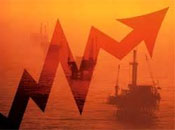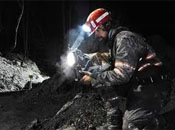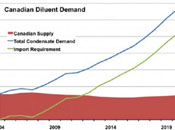
Thanks to the fracking boom of the last few years North America is now on a path toward energy self-sufficiency.
In fact, the International Energy Agency (IEA) now believes that, thanks to astonishing growth in oil and natural gas output, the U.S. could even become a net exporter of natural gas by 2020, and even net-energy self-sufficient by 2035.
According to IEA estimates, the U.S. is already the world's No. 2 natural gas producer.
The IEA has also indicated that increasing production from Canadian oil sands means North America could become a net oil exporter. And by 2035, it's forecast that nearly 90% of Middle Eastern oil exports will find a home in Asia.
These tectonic energy shifts have not gone unnoticed by OPEC and large state-owned energy companies. Major Asian and Middle Eastern interests have already made major acquisitions in Canada and the U.S., with an eye towards many more.
Every day it seems the energy scene is changing at a lightning pace, creating a new world order in energy.
So to gain further insight into this rapidly changing climate, I recently sat down with energy consultant Peter Barker-Homek, a true energy insider.
Peter is the founder of Eta Draco, an advisory firm focused on building operations and capital structures to provide for enduring growth and to anticipate cyclical downturns for small- to medium-sized enterprises.
Mr. Barker-Homek knows more than a thing or two about the global energy sector.
As the previous CEO at TAQA, the Abu Dhabi national energy company, and a seasoned energy executive in a Fortune 20 company, Peter has completed $40 billion in energy-related transactions.
He has more than 20 years' experience in major markets worldwide, and even served in the U.S. Department of State and the U.S. Marine Corps as an Officer/Pilot. He has appeared on CNN, BNN, CNBC, Sky News, Bloomberg TV, BBC Radio, Al Jazeera, and CrossFire, and is regularly cited in industry journals and periodicals.
I think you'll enjoy what Peter had to say during our recent Q&A.
If I did my job right, some of it may even shock you.
Insights on the New World Order in Energy
Krauth: Fracking has become a major source of shale oil and gas production in the U.S. and Canada. How do you see the future of this subsector of the industry?
Barker-Homek: Drilling for oil and natural gas in shale rock is supporting 1.7 million U.S. jobs this year, including workers outside the energy industry, according to researcher IHS Global Insight, and could double over the next 10 years.
Cheap natural gas will bring industry back to the USA and Canada from emerging markets such as China. We are already seeing industries that were deemed only to be competitive in Asia now returning to North America.
Think of the political impact of not having to import 8% of our oil from Venezuela or 45% of our oil from the Middle East and North Africa!
The abundance of shale gas brings the possibility of low, stable prices. North America has approximately 4.2 quadrillion (4,244 trillion) cubic feet of recoverable natural gas that would supply 175 years' worth of natural gas at current consumption rates.
Krauth: Could it really lead to energy independence for America?
Barker-Homek: 2012 saw the U.S. providing for 83% of its oil needs and close to 100% of its natural gas supply. If we have a GDP contraction as predicted -- if we fall off the fiscal cliff -- then the U.S. could be energy independent by the end of 2013 and will, on its current trajectory, with current growth forecasts, reach energy independence by 2020.
OPEC has already started to recognize this, and with other national oil companies begun lobbying for stringent regulation of oil and gas shale production. This is merely a deceptive effort with the real aim to protect their market dominance.
It is also the reason the "New Seven Sisters" are buying up assets worldwide.
The "new seven sisters," or the most influential energy companies from countries outside the Organization for Economic Co-operation and Development, have been identified as Saudi Aramco, Russia's Gazprom, CNPC of China, NIOC of Iran, Venezuela's PDVSA, Brazil's Petrobras, and Petronas of Malaysia.
Overwhelmingly state-owned, they control almost one third of the world's oil and gas production and more than one third of its total oil and gas reserves. In contrast, the old Seven Sisters - which shrank to four in the industry consolidation of the 1990s - produce about 10% of the world's oil and gas and hold just 3% of its reserves.
The IEA calculates that 90% of new supplies will come from developing countries in the next 40 years. That marks a big shift from the past 30 years, when 40% of new production came from industrialized nations, most of it controlled by publicly listed Western energy groups, noted a report published by Rice University's James A. Baker III Institute of Public Policy.
Meanwhile, national oil companies are banding together to help to develop each other's reserves, leaving growth in the oil and gas industry -- and the resources for world economic development - in the hands of the new Seven Sisters and the governments that control them. The consequences of this could hardly be more profoundwhen you add that the new Seven Sisters have strategic alliances in all major markets with the remnants of the old Seven Sisters - The group comprised Anglo-Persian Oil Company (now BP); Gulf Oil, Standard Oil of California (SoCal) and Texaco (now Chevron); Royal Dutch Shell; Standard Oil of New Jersey (Esso) and Standard Oil Company of New York (Socony) (now Exxon Mobil).
Krauth: What do you expect from the Obama administration's Bureau of Land Management (BLM) regarding regulation for this industry?
Barker-Homek: The Obama administration sees energy independence as fundamental to U.S. national security. The increase in transportation mileage standards and drives towards greater efficiency will be blended with robust development in oil and gas exploration and development, renewables (wind & solar) and hybrid/electric vehicles.
The EPA will continue to develop and enforce stronger environmental regulations that will consider the full value chain. Specifically, developing oil and gas shale plays at the expense of agriculture or community health is not a sustainable approach.
BLM will continue to open federal lands. The rules are clear and responsible, containing three parts:
- All chemicals used in hydraulic fracturing must be publicly disclosed following the completion of fracking of a given well.
- New guidelines for how drillers case (enclose) drilled wells, which must be approved prior to drilling the well.
- Drillers must submit and have approved water management plans prior to drilling - plans that include how wastewater will be disposed.
Krauth: What's your take on the current and near-term potential of mergers and acquisitions in this space?
Barker-Homek: The oil and gas sector now has $154.2 billion in announced global deals [this year], according to Dealogic. That puts it in the top spot, above real-estate and technology.
- Midstream consolidation: Driving the midstream numbers was the largest oil and gas deal of the past year, Kinder Morgan's acquisition of El Paso Corp. for $36.7 billion in May. This deal highlights the degree of consolidation occurring in this space, especially around transmission and storage of natural gas.
- Shale oil and gas portfolio moves: Chinese companies were notably active in the U.S. shale oil and gas sector. Sinopec International Petroleum Exploration & Production, a subsidiary of China Petroleum & Chemical Corp., acquired a 33% stake in interests in Niobrara, Mississippian, Utica Ohio, Utica Michigan and Tuscaloosa shale oil fields from Devon Energy for $2.5 billion. PetroChina Co. Ltd. acquired shale gas assets in Groundbirch, Canada from Royal Dutch Shell for $1.3 billion.
Krauth: About 7 years ago a number of sovereign wealth funds met with the IMF in Santiago to outline numerous guidelines on governance, transparency, audits, investment concentrations, etc. How much do these funds control and what's their track record regarding those best practices?
Barker-Homek: Recent estimates have sovereign wealth funds managing $7 trillion in assets and state-owned enterprises holding some $60 trillion in assets!
Let me be clear on this point. Assets held by state-owned enterprises dwarf the free market! They have been linked in every democratic representative government that they have invested into to corrupting politicians, judges, business leaders, and effecting regulation and legislation that is detrimental to the citizens of those democracies. It goes without saying that their investments in totalitarian states have only led to further exploits of the citizenry and the environment.
There is a striking correlation between a country's democracy standards and the transparency, good governance, and accountability standards of its sovereign wealth funds/state-owned enterprises (SWF/SOE).
For example, on track records:
- CNOOC (China National Offshore Oil Corp.) has been implicated in working with a prominent drug trafficker in Burma, as well as numerous human rights violations and environmental destruction of Ramree Island and the infamous Bohai Bay oil spill.
- Petronas has been named in a prominent U.S. Foreign Corrupt Practices Act violation for soliciting and receiving bribes (U.S. vs. Carson).
- Ralls Corporation (China) was attempting to build wind farms near sensitive U.S. military facilities.
State-owned enterprises are an obstacle and, indeed, a cancer to competitive markets. No investment should be allowed by any nation without full reciprocity and mandatory public listing in both the country of origination and the foreign nation to be invested within.
As one example, Petronas has $200 billion invested in 35 nations, yet not one government has raised anti-trust issues - as we look into SWF/SOE behavior, it is clearly to achieve market dominance with the end state being market manipulation. Petronas has horrible environmental, human rights, and corruption records. It has no business investing in free markets until they institute the Santiago Principles, 100%. The Canadian government will be doing a disservice to Canadians should it let the Petronas deal progress.
Canada is well on its way to becoming a colony of China. Its political leaders seem devoid of any credible insight into the sovereign risks they are exposing Canadians to by allowing SOEs to sweep up their national treasures - like Progress Energy, Nexen and Talisman, to name a few.
No SWF or SOE should be allowed to invest in a nation without its citizens being able to hold an interest in their public listing.
Krauth: Can you give us an example of a state-owned energy company that tries to meet the Santiago Principles? What do they do differently?
Barker-Homek: Of the 26 nations' sovereign wealth funds/state-owned enterprises (SWF/SOE) that agreed to the Santiago Principles, only four are truly compliant: the Superannuation Fund of New Zealand, the Government Pension Fund of Norway, the Australian Future Fund, and the Irish National Pension Reserve Fund.
The IWG (Int'l. Working Group) said the purpose of the Santiago Principles was to:
- Establish transparent and sound governance standards that provide for operational controls, risk management, and accountability.
- Ensure compliance with applicable regulatory and disclosure requirements in the countries in which the SWF/SOE operate.
- Ensure SWF/SOE invest on the basis of economic and financial risk and return-related considerations, and
- Help maintain a stable global financial system and free flow of capital and investment.
Notably, OPEC members Russia and China are the least compliant.
Krauth: With rising concerns for energy protectionism, where do you see the industry headed? Are the Santiago Principles likely to be more widely adopted?
Barker-Homek: Transparency builds trust and understanding - in the absence of transparency; protectionism is the only suitable response. [The Santiago Principles are likely to be more widely adopted] only if the IMF, World Bank, multi-lateral, bi-lateral, and domestic regulators look to fulfill their fiduciary obligations to the global market and their constituents.
In Beijing's feverish quest to secure the energy it needs for China to develop, CNPC has fanned out across the globe into about 20 countries from Azerbaijan to Ecuador. It has pumped more than $8 billion into the oil industry of war-torn Sudan, when concerns over human rights deter others in the industry from involvement with Khartoum. "CNPC are the rule makers on access to new reserves in new markets and they are changing the competition for resources, services, capital and markets," says Robin West, chairman of PFC Energy, an industry consultancy.
No other company keeps Europe, and increasingly Asia, on tenterhooks more than [Russia's] Gazprom. As a tool of the Kremlin, it has been involved in a gas dispute with Ukraine, a debate with Japan and China over competing pipelines from Siberia, as well as the grab of Royal Dutch Shell's majority stake in the Sakhalin II liquefied natural gas project. Gazprom has increased its influence with upstream deals in central Asia, including Iran. Downstream, its push into the European market has set off moves to limit its access.
President Hugo Chávez this year signed a law that allows Petróleos de Venezuela S.A. (PDVSA) to seize control of the $30 billion Orinoco Belt heavy crude oil projects. PDVSA's production is shrinking but it is still important to the fortunes of international energy groups, many of whose contracts are being rewritten.
Krauth: Do you have any final words of advice for subscribers regarding your energy outlook?
Barker-Homek: The global economy is on the mend; supplies are keeping up with demand for now; constraints and bottlenecks will plague the industry as well as human capital shortages. Spending on infrastructure is going to be intense.
My energy company picks are:
World Fuel (NYSE:INT), Murphy Oil (NYSE:MUR), Cabot Oil & Gas (NYSE:COG); EOG Resources (NYSE:EOG); SM Energy (NYSE:SM); Transocean (NYSE:RIG); Ensco (NYSE:ESV); Noble (NYSE:NE); Lufkin Industries (Nasdaq:LUFK); and Geospace (Nasdaq:GEOS)
So there you have it. The thoughts and recommendations of one of the most experienced and sought after energy consultants in the industry.
As the world moves forward, developed and developing nations will continue to face both major challenges and major opportunities.
Perhaps most revealing to readers are Peter's views that North America could become energy independent much sooner than most think, and that SWF/SOE are only marginally motivated by profits, easily superseded by politics, policy, military and intelligence goals.
Such insights are worthy of careful consideration as you make your next investment decisions in the energy space. Take the time to research and get expert opinions before you allocate your hard-earned funds.
There's little doubt that energy will maintain and likely augment its position as a premier investment sector. It pays to stay informed.
Peter Krauth
Money Morning























































